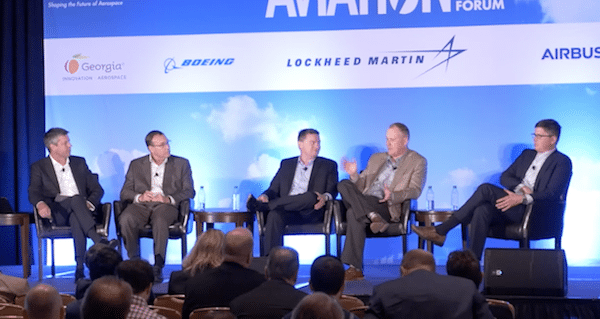
Panelists from Aerion, Boom Supersonic, Lockheed Martin and the FAA discuss the future of supersonic air travel at AIAA Aviation 2018.
Future supersonic aircraft OEMs will need engine and artificial vision technology that does not exist today and has no current methods for being certified. Experts from the supersonic development community explained what their future airframes require to make the next generation of high-speed air travel a reality during a panel Friday at the 2018 AIAA Aviation Forum.
“Not being able to see the runway with your physical eyes is a big deal,” said David Richardson, director for air vehicle design and technology for the advanced development programs division of Lockheed Martin.
The pilot vision problem on approach stems from the design of the nose on supersonic aircraft, which has to be unusually long and sharp for aerodynamic purposes. For example, pilots on the aviation industry’s last viable supersonic passenger jet, the Concorde, had difficulty seeing over the nose during landing and takeoff due to its high angle of attack.
Richardson is part of Lockheed Martin’s design team leading the development of the X-59 QueSST, the low-boom flight demonstrator NASA plans to start using for supersonic test flights over select communities within the U.S. by 2022. He said a key focus in terms of cockpit avionics for Lockheed in constructing the X-59 will be artificial vision.
“For the X-59, we have artificial vision. The pilot cannot see the runway on approach. NASA is working on systems to look at takeoff and landing. We have a redundant system there, there’s also a system for see and avoid so we can see air traffic,” said Richardson.
Outside of the need for a vision system aiding pilots in takeoff and landing, Richardson and others on the AIAA panel said that the key focus for future supersonic aircraft will be improved engine technology. Among today’s major aircraft engine OEMs, none have provided plans to design an all-new engine specifically for supersonic aircraft.
Instead, companies such as Aerion and Boom Supersonic developing future supersonic airframes are looking at how they can tweak subsonic engine designs to meet their needs. Mike Hinderberger, SVP for aircraft development at Aerion, said one of the reasons the planned speed for its Aerion AS2 aircraft will be Mach 1.4 is that it’s the maximum speed the subsonic engine design they’re using can support.
“We’d love to go Mach 2 or 2.5, the other thing that is important is range, max range, minimize land takeoff noise, balancing wave drag looking for existing tech in the engines, you get to a point where 1.4 is where we’re today,” said Hinderberger. “This is a new paradigm when we really start focusing on this for future aircraft there will be bespoke engines and that can change. Where technology is today that’s close to where we feel the limit is right now.”
In contrast, Colorado-based Boom Supersonic, which plans to fly its first demonstrator next year still has not selected an engine partner. According to Boom Supersonic CEO Blake Scholl, who was also on the AIAA panel, they plan to make a selection fairly soon.
“Getting a power plant has been a big focus area, we’ve made some great progress on that front. Not having an announced engine, hopefully that problem will get resolved soon,” said Scholl.